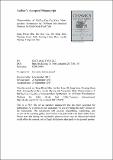Files in this item
Characteristics of Ba(Zr0.1Ce0.7Y0.2)O3-δ nano-powders synthesized by different wet-chemical methods for solid oxide fuel cells
Item metadata
| dc.contributor.author | Min, Sung Hwan | |
| dc.contributor.author | Lee, Jin Goo | |
| dc.contributor.author | Jeon, Ok Sung | |
| dc.contributor.author | Park, Myeong Geun | |
| dc.contributor.author | Ryu, Kwang Hyun | |
| dc.contributor.author | Myung, Jae-ha | |
| dc.contributor.author | Shul, Yong-Gun | |
| dc.date.accessioned | 2018-09-26T23:45:55Z | |
| dc.date.available | 2018-09-26T23:45:55Z | |
| dc.date.issued | 2018-01 | |
| dc.identifier | 251190696 | |
| dc.identifier | 9239af0f-beb7-4c7f-af6e-af0cc3a9a056 | |
| dc.identifier | 85034002459 | |
| dc.identifier | 000416877900061 | |
| dc.identifier.citation | Min , S H , Lee , J G , Jeon , O S , Park , M G , Ryu , K H , Myung , J & Shul , Y-G 2018 , ' Characteristics of Ba(Zr 0.1 Ce 0.7 Y 0.2 )O 3-δ nano-powders synthesized by different wet-chemical methods for solid oxide fuel cells ' , Ceramics International , vol. 44 , no. 1 , pp. 433-437 . https://doi.org/10.1016/j.ceramint.2017.09.195 | en |
| dc.identifier.issn | 0272-8842 | |
| dc.identifier.other | RIS: urn:10A6244F88E2CEFB465372FDD922A0FA | |
| dc.identifier.uri | https://hdl.handle.net/10023/16085 | |
| dc.description | This research was supported by Basic Science Research Program through the National Research Foundation of Korea (NRF) funded by the Ministry of Education (NRF-2017R1A6A3A03004416) and (NRF-2015M1A2A2056833). | en |
| dc.description.abstract | Ba(Zr0.1Ce0.7Y0.2)O3-δ nano-particles were prepared by different wet-chemical synthesis, Pechini (BZCY(P)) and co-precipitation (BZCY(C)), respectively. The BZCY(C) powders have a particle size in range of about 50~150 nm, which is smaller than the BZCY(P) powders with about 500~900 nm. Both the BZCY materials show perovskite structures, but there are impurities in the BZCY (P). Moreover, the electrolyte density was higher in the BZCY (C) than the BZCY (P). The single cells with BZCY (C) electrolytes exhibited about 0.23 W cm−2 at 600 °C and about 0.31 W cm−2 at the same temperature were obtained when the anode-functional layer was introduced between the anode and electrolyte. Thus, the BZCY prepared by carbonate-derived co-precipitation method can be more favorable for high-purity and dense electrolytes in the solid oxide fuel cells than the BZCY prepared by Pechini method. | |
| dc.format.extent | 1111577 | |
| dc.language.iso | eng | |
| dc.relation.ispartof | Ceramics International | en |
| dc.subject | Solid oxide fuel cell | en |
| dc.subject | BZCY | en |
| dc.subject | Functional layer | en |
| dc.subject | Nickel penetration | en |
| dc.subject | Proton conductor | en |
| dc.subject | QD Chemistry | en |
| dc.subject | NDAS | en |
| dc.subject.lcc | QD | en |
| dc.title | Characteristics of Ba(Zr0.1Ce0.7Y0.2)O3-δ nano-powders synthesized by different wet-chemical methods for solid oxide fuel cells | en |
| dc.type | Journal article | en |
| dc.contributor.institution | University of St Andrews. School of Chemistry | en |
| dc.identifier.doi | https://doi.org/10.1016/j.ceramint.2017.09.195 | |
| dc.description.status | Peer reviewed | en |
| dc.date.embargoedUntil | 2018-09-27 |
This item appears in the following Collection(s)
Items in the St Andrews Research Repository are protected by copyright, with all rights reserved, unless otherwise indicated.

